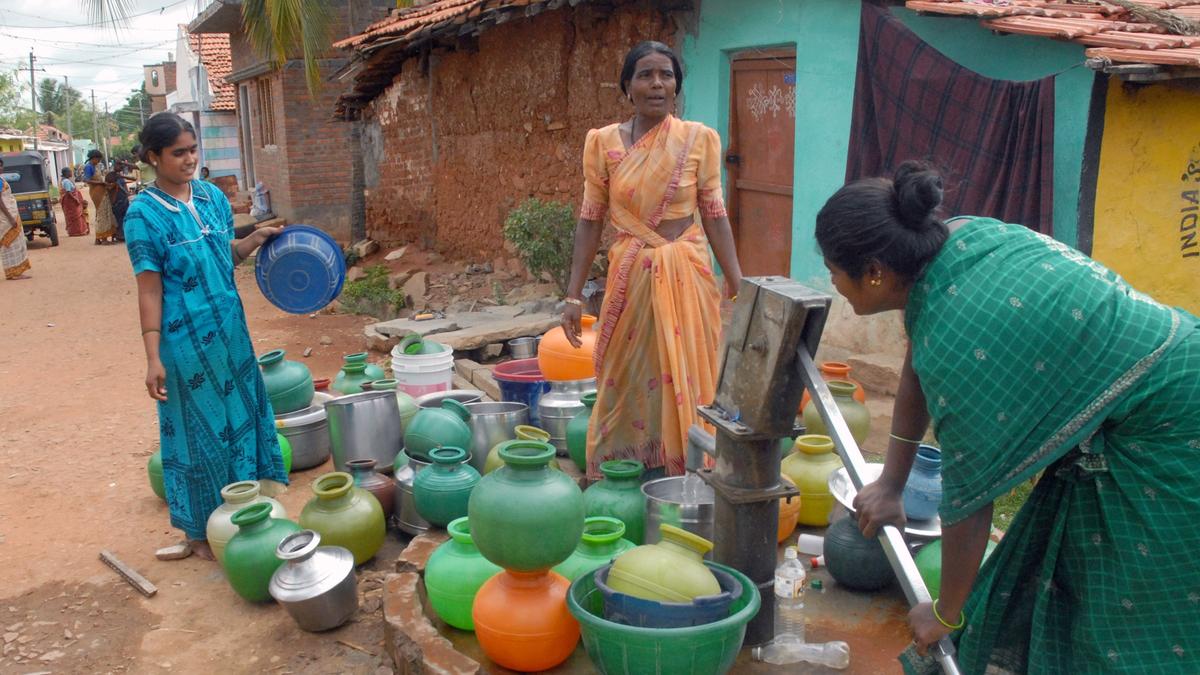Groundwater Contamination in India

- 12 Aug 2025
Introduction:
Groundwater is the backbone of India’s water economy, meeting more than 85% of rural drinking water needs and nearly 65% of irrigation requirements. Traditionally considered a safe and abundant source, aquifers are now increasingly threatened by rising contamination. The presence of nitrates, fluoride, arsenic, uranium, heavy metals, and pathogens in groundwater is creating a silent but severe public health and environmental crisis.
Scale of the Crisis
The 2024 Central Ground Water Board (CGWB) Report highlights contamination across 440 districts, exposing millions to serious health risks. Unlike droughts or floods, groundwater contamination is invisible, cumulative, and often irreversible, making it a formidable challenge to long-term water security.
Sources of Contamination
1. Anthropogenic (Human-Induced):
- Agricultural runoff: Excessive use of fertilisers and pesticides leads to nitrate and phosphate leaching.
- Industrial discharge: Toxic heavy metals like lead, cadmium, and mercury infiltrate aquifers.
- Sewage & septic leakage: Untreated wastewater contaminates rural and peri-urban groundwater.
- Fuel leakage: Petroleum seepage further pollutes drinking water sources.
2. Geogenic (Natural):
- Fluoride: Naturally present in rocks, aggravated by over-extraction.
- Arsenic: Mobilised in Gangetic aquifers due to pumping.
- Uranium: Present in certain geological formations, worsened by phosphate fertiliser use.
Key Contaminants and Health Impacts
|
Contaminant |
Source |
Health Impacts |
Hotspot Regions |
|
Nitrates |
Fertilisers, sewage |
“Blue Baby Syndrome”, cancer risk |
Punjab, Haryana, Karnataka |
|
Fluoride |
Geogenic, fertilisers |
Dental & skeletal fluorosis |
Rajasthan, Andhra Pradesh, Telangana |
|
Arsenic |
Geogenic, over-pumping |
Skin lesions, gangrene, cancer |
Bihar, W. Bengal, Uttar Pradesh |
|
Uranium |
Geogenic, fertilisers |
Kidney & organ toxicity |
Punjab (Malwa), Rajasthan |
|
Heavy Metals |
Industrial waste |
Neurological damage, anaemia |
Kanpur, Vapi |
|
Pathogens |
Sewage leaks |
Cholera, dysentery, hepatitis |
Odisha, Uttar Pradesh |
- Fluoride contamination affects 230 districts, with 66 million people suffering from fluorosis.
- In Jhabua (M.P.), fluoride exceeds 5 mg/L, affecting nearly 40% of tribal children.
- Arsenic in the Gangetic belt has led to skin cancer, gangrene, and respiratory illness.
- Uranium levels in Punjab’s Malwa region exceed WHO limits, causing kidney and organ damage.
- Hospital admissions due to nitrate-linked illnesses rose by 28% in five years.
Structural and Governance Challenges
- Fragmented Institutional Framework: CGWB, CPCB, SPCBs, and Ministry of Jal Shakti work in silos.
- Weak Legal Enforcement: The Water Act, 1974 scarcely covers groundwater quality.
- Poor Monitoring: Infrequent testing, outdated equipment, lack of real-time public data.
- Over-Extraction: Falling water tables concentrate contaminants and draw geogenic toxins.
- Waste Mismanagement: Industrial discharges and poor sewage treatment remain unchecked.
Policy and Reform Recommendations
1. Legal & Institutional Strengthening
- Empower CGWB with statutory powers for regulation.
- Create a National Groundwater Pollution Control Framework.
2. Monitoring & Surveillance
- Deploy real-time quality sensors and remote sensing tools.
- Integrate groundwater monitoring with public health systems (HMIS, IHIP).
3. Targeted Mitigation
- Establish arsenic and fluoride removal plants in hotspots.
- Expand Jal Jeevan Mission’s piped water supply to reduce reliance on contaminated wells.
4. Industrial & Wastewater Management
- Mandate Zero Liquid Discharge (ZLD) for industries.
- Regulate landfills and industrial clusters with stringent penalties.
5. Agricultural Reforms
- Promote organic farming and integrated nutrient management.
- Rationalisefertiliser use through pricing reforms and farmer awareness.
6. Community Engagement
- Involve panchayats, SHGs, and water user groups in quality monitoring.
- Launch school-based water literacy campaigns for behavioural change.
Conclusion
Groundwater contamination in India is more than an environmental issue; it is a public health emergency with far-reaching consequences for society, economy, and sustainability. If left unaddressed, millions will continue to suffer chronic illnesses, agricultural productivity will decline, and water insecurity will worsen. A comprehensive strategy combining science, governance, technology, and community participation is urgently required. Without immediate intervention, India risks an irreversible water and health crisis, undermining both its developmental trajectory and the well-being of future generations.
